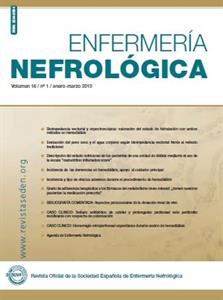Contenido del artículo principal
Resumen
El primer trasplante renal con éxito se llevó a cabo en 1954 y se trató de un trasplante renal de vivo efectuado entre gemelos univitelinos en el Hospital Peter Bent Brigham de Boston1. Este hecho fue histórico ya que ayudó a superar la principal barrera que impedia el éxito de este tratamiento: el rechazo. A partir de 1972 con la aparición de los fármacos inmunosupresores como la ciclosporina2 y años más tarde, con la aceptación de los criterios diagnósticos de muerte encefálica, el trasplante renal de donante fallecido ha prevalecido sobre el de donante vivo. Los últimos datos publicados por la Organización Nacional de Trasplantes (ONT), siguen mostrando que la actividad de trasplante renal realizada en España ha sido prioritariamente de donante cadáver. En 2011 se realizaron 312 trasplantes renales de donante vivo, lo que supone el 12,5% del total de la actividad renal3. A pesar de que estas cifras no son muy altas, hay que destacar el incremento progresivo que ha tenido sobretodo desde el año 2000. Se preeve que la actividad de trasplante renal de vivo siga aumentando en España. El interés por impulsar este tipo de donación, viene influenciada por varios aspectos claramente defi nidos: los buenos resultados obtenidos en la supervivencia4,5,6 y en la calidad de vida7,8,9, el cambio en el perfil demográfico y de comorbilidad del donante fallecido, la mejora en la seguridad del donante y la insuficiente disponibilidad de órganos para el trasplante.
Palabras clave
Detalles del artículo
Derechos de autor 2013 Miguel Ángel Hidalgo-Blanco, Mª Carmen Moreno-Arroyo

Esta obra está bajo una licencia internacional Creative Commons Atribución-NoComercial 4.0.
Aviso de derechos de autor/a
© Los autores ceden de forma no exclusiva los derechos de explotación de los trabajos publicados y consiente en que su uso y distribución se realice con la Licencia Creative Commons Atribución - No comercial 4.0 Internacional (CC BY-NC 4.0). Puede consultar desde aquí la versión informativa y el texto legal de la licencia. Esta circunstancia ha de hacerse constar expresamente de esta forma cuando sea necesario.
Referencias
- Murray JE, Merril JP, Hartwell Harrison J. Renal homotransplantations in identical twins. Surg Fo-rum 1995;VI:432-436.
- Borel JF, Feurer C, Gubler HU, Stahelin H. Biologi-cal effects of cyclosporin A: a new antilymphocyte agent. Agents Actions 1976: 468-475.
- Memoria de actividad de donación y trasplante 2011. Página web de la Organización Nacional de Trasplantes.Disponible en: último acceso: 9 de Febrero del 2013.
- Data on organ donation and transplantation. Organ Procurement Transplant Net-work Web site. Dispo-nible en: http://optn.transplant.hrsa.gov/latestDa-ta/rptStrat.asp. Último acceso: 8 de Febrero del 2013.
- Cecka JM. The UNOS Scientifi c Renal Transplant Registry. Clin Transpl 2001; 1-18.
- Solà R, Vela E, Cleries M, Guirado LI, Díaz JM, Facundo C, Deulofeu R. Living donor kidney trans-plantation in Catalonia: comparison with cadave-ric kidney donors. Transplant Proc 2007; 39 (7): 2208-9.
- Garcia MF, Andrade LG, Carvalho MF. Living kid-ney donors – a prospective study of quality of life before and after kidney donation. Clin Transplant. 2013 Jan;27(1):9-14.
- Coelho JC, Parolin MB, Baretta GA, Pimentel SK, De Freitas AC, Colman D. Donor quality of life after living donor liver transplantation. Arq Gastro-enterol 2005: 42: 83.
- Lumsdaine JA, Wray A, Power MJ et al. Higher qualityof live in living donor kidney transplanta-tion: prospective cohort study. Transpl Int 2005: 18: 975.
Referencias
Murray JE, Merril JP, Hartwell Harrison J. Renal homotransplantations in identical twins. Surg Fo-rum 1995;VI:432-436.
Borel JF, Feurer C, Gubler HU, Stahelin H. Biologi-cal effects of cyclosporin A: a new antilymphocyte agent. Agents Actions 1976: 468-475.
Memoria de actividad de donación y trasplante 2011. Página web de la Organización Nacional de Trasplantes.Disponible en: último acceso: 9 de Febrero del 2013.
Data on organ donation and transplantation. Organ Procurement Transplant Net-work Web site. Dispo-nible en: http://optn.transplant.hrsa.gov/latestDa-ta/rptStrat.asp. Último acceso: 8 de Febrero del 2013.
Cecka JM. The UNOS Scientifi c Renal Transplant Registry. Clin Transpl 2001; 1-18.
Solà R, Vela E, Cleries M, Guirado LI, Díaz JM, Facundo C, Deulofeu R. Living donor kidney trans-plantation in Catalonia: comparison with cadave-ric kidney donors. Transplant Proc 2007; 39 (7): 2208-9.
Garcia MF, Andrade LG, Carvalho MF. Living kid-ney donors – a prospective study of quality of life before and after kidney donation. Clin Transplant. 2013 Jan;27(1):9-14.
Coelho JC, Parolin MB, Baretta GA, Pimentel SK, De Freitas AC, Colman D. Donor quality of life after living donor liver transplantation. Arq Gastro-enterol 2005: 42: 83.
Lumsdaine JA, Wray A, Power MJ et al. Higher qualityof live in living donor kidney transplanta-tion: prospective cohort study. Transpl Int 2005: 18: 975.




